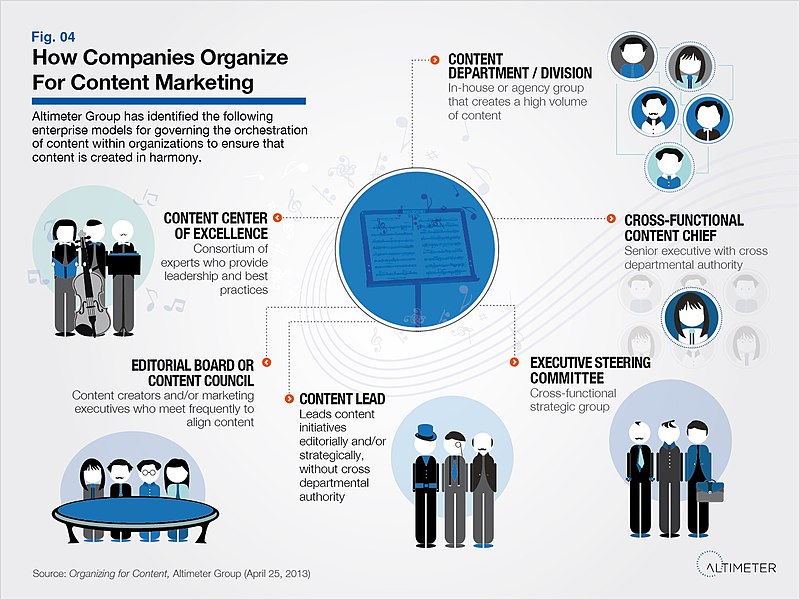What Is Digital Marketing?
Digital marketing is the use of websites, apps, mobile devices, social media, search engines, and other digital means to promote and sell products and services.Digital marketing involves many of the same principles as traditional marketing and is often considered an additional way for companies to approach consumers and understand their behavior. Companies often combine traditional and digital marketing techniques in their strategies. But digital marketing also comes with its own set of challenges. Digital marketing started to become popular with the widespread adoption of the internet in the 1990s.
Content marketing
is a strategic marketing approach focused on creating and distributing valuable, relevant, and consistent content to attract and retain a clearly defined audience. It ultimately aims to drive profitable customer action.
Content marketing is an umbrella term covering a set of strategies, techniques, and tactics to fulfil business and customer goals by using the most relevant content to serve, attract, convert, retain, and engage customers. Content uses blogs, podcasts, video, and social media sites as a vehicle. It’s a practice now being used by 86% of businesses today. However, effective content marketing is not so easy to find.

Goals of Content Marketing
Given the fact that content plays a role in virtually all marketing techniques and tactics, there are no goals that can’t be reached using content. However, from a content marketing perspective, we see that marketers focus on some key goals such as −
- Brand awareness
- Lead generation
- Engagement
- Sales
- Lead nurturing
- Customer retention and loyalty
- Customer evangelism
- Up-selling and cross-selling
KEY TAKEAWAYS
- Digital marketing promotes products and services through channels such as websites, mobile devices, and social media platforms.
- Digital marketers have a number of tools to measure the effectiveness of their campaigns.
- One of the biggest challenges digital marketers face is how to set themselves apart in a world that is oversaturated with digital ads and other distractions.
How Digital Marketing Works
Marketing encompasses a wide range of techniques and media that companies can use to promote their products and services to potential consumers and improve their market share. To be successful, it requires a combination of advertising and sales savvy. Professional marketers take on these tasks either internally at individual companies or externally at marketing firms that may serve many different clients.
How to Use Rank Math’s Content AI for SEO
Artificial Intelligence (AI) is already a part of our everyday life, starting with the simplest search in Google to powering complex computations — AI has already made its way.
AI-powered technologies are well-known for performing our day-to-day tasks effortlessly, and Rank Math has taken advantage of AI to help you optimize your website for search engines.
Meet Content AI.
Our Content AI is built to be used right inside your WordPress Editor to offer sophisticated suggestions for related keywords, questions, and links. So you can use them inside your content, headings, or meta tags, and on the whole, put together an SEO-friendly article & start driving traffic.
Not only this, our Content AI allows you to access 40+ AI tools to assist in creating and improving your content within a few seconds.
You don’t have to install a separate plugin to access Content AI; all the features are readily available within Rank Math SEO. Subscribe to a Content AI plan of your choice and get started right away!
So, without further ado, let’s dive into our new Content AI module and how you can take advantage of our AI-powered suggestions to improve/optimize your content creation.

Companies once focused on marketing through print, television, and radio because that was all they had. Although those options still exist, the internet gave companies another way to reach consumers and gave rise to digital marketing.
The new technologies and trends forced companies to change their marketing strategies and rethink their budgets. Email became a popular marketing tool in the early days of digital marketing. Then the focus shifted to search engines like Netscape, which allowed businesses to tag and keyword items to get themselves noticed. The development of social platforms like Facebook made it possible for companies to track user data and deliver their messages to very specific audiences.
Types of Digital Marketing Channels
Digital marketing channels have evolved since the 1990s and continue to do so. Here are eight of the most common channels in use today.
Website Marketing
Companies often use their own website as the centerpiece of their digital marketing activities. The most effective websites represent the brand and its products and services in a clear and memorable way. A website today must be fast-loading, mobile-friendly, and easy to navigate.
Pay-Per-Click Advertising
Pay-per-click (PPC) advertising enables marketers to reach audiences on news and other websites and digital platforms through paid ads. Marketers can set up PPC campaigns on Google, Bing, LinkedIn, X (formerly Twitter), Pinterest, and Facebook and show their ads to people searching terms related to their products or services.
These campaigns can segment users based on their demographic characteristics (such as age or gender), or their particular interests or location. The most widely used services for PPC are Google Ads and Facebook Ads.
Content Marketing
The goal of content marketing is to reach potential customers through the use of written, visual, or video content that interests them. That content is usually published on a website and then promoted through social media, email marketing, search engine optimization, or even pay-per-click campaigns. Content marketing attempts to be more subtle than advertising, and the product or service the sponsor is attempting to market may or may not be conspicuously highlighted.
Email Marketing
Email marketing is still one of the most effective digital marketing channels, though many people associate it with spam and treat such messages accordingly. Many digital marketers use their other digital marketing channels to collect names for their email lists. Then, through email marketing, they try to turn those leads into customers.

Social Media Marketing
The primary goals of a social media marketing campaign are to build brand awareness and establish trust. As you go deeper into social media marketing, you can use it to obtain leads and as a direct marketing or sales channel. Promoted posts and tweets are two examples of social media marketing.
Affiliate Marketing
Affiliate marketing is one of the oldest forms of marketing, and the digital world has given it new life. In affiliate marketing, companies and individual “influencers” promote another company’s products and get a commission every time a sale is made or a fresh lead is added to their list. Many well-known companies, including Amazon, have affiliate programs that pay out millions of dollars to affiliates that help sell their products.
Video Marketing
A lot of internet users turn to sites like YouTube before making a buying decision, to learn how to do something, to read a review, or just to relax. Marketers can use any of several video marketing platforms, including Facebook Videos, Instagram, and TikTok, to run a video marketing campaign. Companies find the most success with video by integrating it with SEO, content marketing, and broader social media marketing campaigns.

Video marketing statistics
Statista projects that the number of Internet users who watch streaming or downloaded video at least once per month will reach nearly 3.5 billion worldwide by 2023. Not only is the number of digital video viewers continuously increasing, but so is the amount of time spent watching videos. In the US, adults spent nearly 2.5 hours (149.04 minutes) with digital video content per day in 2021; this number is expected to grow to 162.52 minutes in 2023.
Advertising spend is rising alongside viewers and viewing time. In 2022, US advertisers will spend $24.35 billion on video in social media marketing (advertising that appears on social networks), up 20.1% year over year. US advertisers will also spend $62.96 billion on programmatic digital video this year, up from $52.17 billion in 2021.
Text Messaging
Companies also use text messages (formally known as SMS, or short message service) to send information about their latest products and promotions. Nonprofit organizations and political candidates also use texting to promote themselves and solicit donations. Today many marketing campaigns make it possible for consumers to make a payment or donation via a simple text message.
Marketing is how you let people know that your business exists and what you can do for them. It’s how you promote your products or services, and it’s how you evolve your organization. But, there are many marketing strategies, and choosing from them can feel daunting—especially if marketing isn’t your specialty. The good news is that there are many tactics you can implement. One thing you can do is explore straightforward, easily managed strategies, such as text message marketing.
It’s an ideal marketing strategy for many businesses, including small and medium-sized companies, because you can easily control the budget, scale, and content of your campaign. Text message marketing is laser-focused, making it easy for you to run it in a way that’s effective for your business. Read on to learn all the essentials you need to know to get started.
What is text message marketing?
Have you ever received a text message from a company trying to sell you something? Maybe they were offering an extended warranty for your mobile device or providing information on a super sale they’re having.
This is text message marketing, and it’s exactly what the name implies. This marketing technique encourages companies to reach out to people with special offers or advertisements via text messages. It’s a tried and true way to open marketing communication with potential customers, but before you dive right into it, there are a few important things to learn.
Performance Indicators (KPIs) in Digital Marketing
Digital marketers use key performance indicators (KPIs) just like traditional marketers. KPIs let them measure the long-term performance of their marketing initiatives and compare those to their competitors’ efforts.
The following are some of the most common KPIs that marketers can use to gauge how well they’re doing:
- Click-through rate: This KPI is commonly used to measure the effectiveness of online advertising, by counting the number of people who clicked on a particular ad as a percentage of all the people who might have seen it.
- Conversion rate: The conversion rate goes even further than the click-through rate to compare the percentage of people who took some desired action, such as making a purchase, to the total audience that a particular ad or promotion reached.
- Social media traffic:This tracks how many people interact with a company’s social media profiles. It includes likes, follows, views, shares, and/or other measurable actions.
- Website traffic: This metric tracks how many people visit a company’s website during a given time period. Among other uses, it can help companies judge how effective their marketing efforts are at driving consumers to their site.
What Is a Digital Marketing Agency?
A digital marketing agency is a company that deals exclusively in marketing to consumers or businesses through digital channels. This includes creating and launching campaigns for clients through social media, pay-per-click advertising, videos, and custom websites, among other means.
What Is SEO in Digital Marketing?
Search engine optimization (SEO) describes a variety of techniques that companies use in an effort to increase traffic to their website and raise its position in search results. The higher a site appears on the search results page, the more likely consumers are to see it and potentially click to visit it.
Why is SEO marketing important?
Search engines are the primary way in which users discover websites. So, whether you produce informational content or commercial products, being seen in search by users is a large part of running a successful website.
In commerce, 59% of shoppers use Google Search to research a purchase they plan to make in-store or online, while around half of consumers use Google to discover new products.
With that in mind, ecommerce SEO is a crucial part of ensuring your site appears early and often in search engine results for terms related to your offering. No matter how great your website might be, the simple truth is that visitors are unlikely to find you if your search rankings are low.
Types of SEO marketing
SEO activities fall into three general categories. Let’s take a look at them:
- On-page SEO
- Off-page SEO
- Technical SEO
1. On-page SEO
The largest bucket of SEO marketing activities, on-page SEO involves optimizing the content of your website (including text, images, and videos) to ensure visitors and search engines can understand and navigate the information you publish.
Search engines look for on-page factors that help determine the quality of your content and, in turn, where to rank your site in results pages. Examples of on-page SEO factors include topic relevance, metadata, and the slug in your page URL.
Topic relevance
Web pages that rank highly in search engines contain content that closely matches the search intent of users. That means you need to think about what searchers are looking for when they enter queries, and provide the information or services they’re seeking.
Best practices for producing SEO content include offering original information, updating facts regularly, and sticking to topics within your website’s area of expertise.
Internet Marketing
Technically, internet marketing is marketing that takes place solely on the internet. As such, it is a subset of digital marketing, which can use many different kinds of digital platforms, including the internet, to reach its desired audience.
How Can You Become a Digital Marketer?
Digital marketers need strong writing and social media skills, along with a good understanding of data analytics. A bachelor’s degree is required for most digital marketing positions. You might also want to take digital marketing courses or participate in a digital “boot camp.” In addition, completing an internship while in school can be useful.2 A master’s degree in digital marketing may be useful but is not considered essential.
What Skills Are Needed in Digital Marketing?
Strong communication skills are essential for a marketer to successfully communicate a company or product’s story to potential customers. Additionally, data analytics skills are important for understanding the performance of a marketing campaign and identifying areas for improvement. Lastly, social media skills are also crucial.
What Is Implicit Bias in Digital Marketing?
Implicit bias, also known as unconscious bias, refers to messages that unintentionally convey negative stereotypes or derogatory attitudes toward certain groups. In recent years it has come in for particular notice in the fields of advertising and marketing. In digital marketing it may manifest itself in something as simple as the choice of stock photos for a marketing campaign. For instance, without even thinking about it, companies may use images of only heterosexual White individuals while excluding Black, Indigenous, and other people of color, along with those of different body types and abilities. While digital marketers often use supposedly unbiased algorithms to help craft their campaigns, those algorithms are created by human beings who may bring their own unconscious biases to them.
The Bottom Line
The ways in which people consume media in the 21st century have caused marketers to put increased, and sometimes exclusive, emphasis on digital platforms for their campaigns. While digital marketing uses many of the same techniques as traditional marketing through print, television, and radio, it also has its own set of tools that marketers need to master in order to succeed.
Leave a Reply